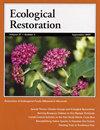Reintroducing Vascular and Non-Vascular Plants to Disturbed Arctic Sites: Investigating Turfs and Turf Fragments
IF 1.1
4区 环境科学与生态学
Q2 ECOLOGY
引用次数: 0
Abstract
ABSTRACT Disturbed low-Arctic environments provide many challenges for ecological restoration, from harsh climates and remote locations to limited knowledge on plant establishment and successional pathways within tundra ecosystems. Due to limited commercially available materials for restoration of native low-Arctic plant communities, transplantation may provide an effective technique for revegetation in these difficult-to-restore environments. In this study, whole-turfs and shredded turfs were harvested from undisturbed upland-heath tundra near Rankin Inlet, Canada, and transplanted onto nearby disturbed gravel quarries to investigate species survivability and development of upland-heath vegetative communities. Two years following transplantation, turfs were found to maintain 85% of the initial vegetative cover and 91% of the initial species richness, with expansion up to 8 cm into the surrounding substrate, and production of seeds and spores. Although shredded turfs were unable to significantly establish vascular species, evidence suggests a shredded turf may establish non-vascular plant cover over a larger area than intact turfs, if given greater protection from environmental stressors. Our results demonstrate that whole-turfs are resistant to harvesting and transplantation stresses, flooding, drought, and poor soil conditions, and are an effective means of species transfer promoting development of vegetative cover on disturbed substrates. High species survivability indicates that turfs have the potential to provide disturbed areas with a wide array of native species, critical for the development of sustainable and self-organizing assemblages of native vegetation.将维管和非维管植物重新引入受干扰的北极地区:研究草皮和草皮碎片
摘要受干扰的低北极环境为生态恢复带来了许多挑战,从恶劣的气候和偏远地区到苔原生态系统中植物建立和演替途径的有限知识。由于用于恢复本地低北极植物群落的商业可用材料有限,移植可能为在这些难以恢复的环境中重新植被提供一种有效的技术。在这项研究中,从加拿大兰金湾附近未受干扰的高地石南苔原中收获整株草皮和切碎的草皮,并将其移植到附近受干扰的砾石采石场,以研究高地石南植被群落的物种生存能力和发展。移植两年后,发现草皮保持了85%的初始营养覆盖率和91%的初始物种丰富度,并向周围基质扩展了8厘米,产生了种子和孢子。尽管切碎的草皮无法显著建立维管物种,但有证据表明,如果能更好地抵御环境压力,切碎的草皮可能会比完整的草皮在更大的面积上建立非维管植物覆盖。我们的研究结果表明,整株草皮能够抵抗收割和移植胁迫、洪水、干旱和恶劣的土壤条件,是物种转移的有效手段,促进了扰动基质上植被的发育。高物种生存能力表明,草皮有潜力为受干扰地区提供广泛的本地物种,这对本地植被的可持续和自组织组合的发展至关重要。
本文章由计算机程序翻译,如有差异,请以英文原文为准。
求助全文
约1分钟内获得全文
求助全文
来源期刊

Ecological Restoration
Environmental Science-Nature and Landscape Conservation
CiteScore
1.70
自引率
12.50%
发文量
24
期刊介绍:
Ecological Restoration is a forum for people advancing the science and practice of restoration ecology. It features the technical and biological aspects of restoring landscapes, as well as collaborations between restorationists and the design professions, land-use policy, the role of education, and more. This quarterly publication includes peer-reviewed science articles, perspectives and notes, book reviews, abstracts of restoration ecology progress published elsewhere, and announcements of scientific and professional meetings.
 求助内容:
求助内容: 应助结果提醒方式:
应助结果提醒方式:


